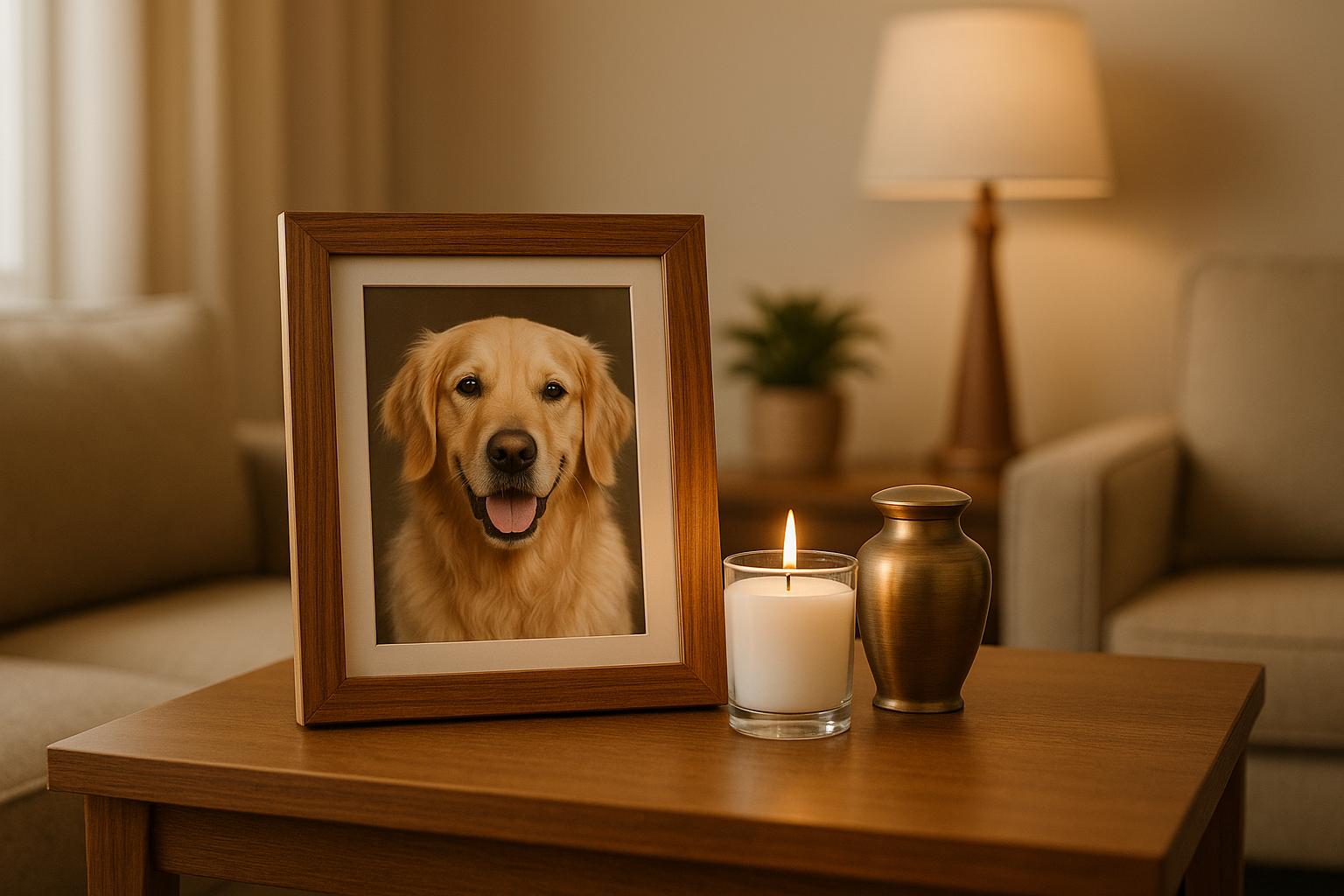Facing the impending loss of a beloved dog is an incredibly difficult experience. Preparing for this moment can help you navigate the emotional journey and ensure your pet receives the compassionate care they deserve. Start by discussing end-of-life options with your veterinarian to understand the choices available, including hospice care and euthanasia.
Taking the time to create special memories with your dog during their final days is essential. This can include comforting rituals, ensuring they feel loved, and providing a peaceful environment. When the time comes, having a trusted partner by your side is crucial. That's where Animal Aftercare comes in; our 24/7 pet and equine cremation and euthanasia services provide you with peace of mind during this challenging time.
Planning ahead can alleviate some of the stress that accompanies a pet's death. Knowing how to say goodbye and what to do afterward can help you cope with the emotional aftermath. Animal Aftercare is dedicated to offering compassionate support and expert guidance through every step, ensuring your pet’s passing is handled with dignity and respect.
Understanding Pet Loss and Grief
Dealing with the loss of a pet can evoke a complex mix of emotions. Recognizing the stages and common feelings that arise during this time is essential for navigating the grieving process.
Stages of Grief
You may experience a range of emotions as you cope with the loss of your dog. The Kübler-Ross model outlines five key stages:
- Denial: Initially, you might feel shock or disbelief, unable to accept the reality of your pet’s passing.
- Anger: Frustration may surface, perhaps directed towards yourself, others, or even the situation.
- Bargaining: You might find yourself dwelling on what could have been done differently to prevent this loss.
- Depression: As reality sets in, deep sadness can emerge, leading to emotional pain and withdrawal.
- Acceptance: Ultimately, you may reach a point of acceptance, coming to terms with your pet's absence.
Each stage is a natural part of your grieving process, influenced by your relationship with your pet and your mental health.
Common Emotions in Pet Loss
Pet loss can bring forth a myriad of feelings. Sadness often overshadows other emotions, manifesting as tears or a sense of emptiness. Alongside this, guilt may arise, making you question your decisions regarding your pet's care.
You might also encounter anger, stemming from feelings of helplessness or frustration about the situation. It's vital to acknowledge these feelings, as they are legitimate aspects of the grieving experience.
Moreover, you may experience relief, especially if your pet suffered. It’s essential to understand that this is a natural response to emotional pain. Support from organizations like Animal Aftercare can help you find comfort during this process, offering 24/7 support for pet cremation and euthanasia. Their compassionate services ensure you can honor your pet’s memory while navigating your grief.
Assessing Quality of Life
Evaluating your dog's quality of life is critical as you prepare for end-of-life decisions. Recognizing the signs of suffering and knowing when to make tough choices can help ensure that your pet is treated with compassion.
Signs Your Pet May Be Suffering
Identifying signs of suffering in your dog is essential to assess their quality of life. Look for changes in behavior, such as increased lethargy or reluctance to engage in activities they once enjoyed.
Other signs might include:
- Loss of appetite: If your dog isn’t eating or drinking consistently.
- Incontinence: Loss of bladder or bowel control can indicate distress.
- Pain expressions: Whining, whimpering, or aggression can be signs of discomfort.
Monitor your dog's mobility as well. Difficulty in standing or walking can significantly affect their quality of life. Recognizing these signs early can facilitate discussions about care options, including potential euthanasia if suffering becomes unbearable.
Making Difficult Decisions
Deciding when to consider euthanasia or palliative care is challenging but necessary. You must weigh your pet’s quality of life against their suffering. A commonly used approach is the assessment of specific criteria, such as their ability to eat, drink, and interact.
You might consider using a quality of life scale. This scale typically evaluates aspects like pain management, joy, and mobility. Each category can be rated from 1 to 10, helping you determine whether their quality of life is acceptable.
If you find your dog consistently scores low across various categories, it reflects an urgent need to evaluate their situation. Animal Aftercare provides compassionate support in making these difficult decisions, ensuring that euthanasia, when necessary, is a humane choice for your beloved pet.
End-of-Life Options
Preparing for your dog's end-of-life can be difficult, but understanding your options is crucial. You can choose between euthanasia and allowing a natural death at home, each with distinct considerations to reflect on.
Euthanasia and What to Expect
Euthanasia is a humane way to prevent suffering when a dog is terminally ill or in severe pain. The process often involves a visit from a veterinarian who administers an injection. You’ll typically be able to hold your pet, providing comfort until the final moment.
Many pet owners opt for services that include cremation, which can be done privately or communally. Private cremation ensures that you receive your pet's ashes, allowing for a meaningful way to remember them. Discuss these options with your veterinarian or services like Animal Aftercare, which offers 24/7 Pet and Equine Cremation and Euthanasia.
Natural Death at Home
Allowing your dog to pass naturally at home can be a peaceful alternative. Create a comfortable environment with their favorite bedding and gentle music. It's essential to monitor their health closely, making sure they have access to food and water.
Considerations include whether to consult your vet for pain management or hospice care. Natural death might also lead you to explore burial options in your yard or a pet cemetery, ensuring your pet rests in a meaningful location. Using Animal Aftercare can provide guidance on respectful burial and memorial options.
Aftercare and Memorialization
After dealing with the immediate grief of losing your dog, the next steps involve making important decisions about aftercare and how to honor their memory. It’s essential to consider options that reflect your feelings and your dog's life.
Cremation or Burial Decisions
You have several options when it comes to handling your pet's remains. Cremation is a popular choice as it allows you to keep your dog's ashes in a special urn or scatter them in a meaningful place. With private cremation, your dog is cremated alone, ensuring you receive only their ashes.
Burial is another option, which can be done at home or in a pet cemetery. When choosing a burial, ensure the site is legally permitted and consider a pet cemetery for professional services. You may also wish to select a biodegradable casket to support environmental sustainability.
Each choice has its emotional significance, so take the time to evaluate what feels right for both you and your dog.
Creating a Lasting Memorial
Memorializing your pet can help in the healing process. Creating a lasting tribute can involve several heartfelt ideas. You might consider a traditional photo album or digital slideshow featuring special moments you shared.
Memorial items such as paw prints, engraved stones, or personalized plaques can serve as a physical reminder of your dog’s life. Additionally, planting a tree or flowers in their memory can create a living tribute.
Animal Aftercare offers thoughtful services, including personalized cremation packages that can include memorial keepsakes. These options help you honor your dog's legacy in a way that feels comforting and significant.
Healing and Support
Experiencing the loss of a dog can be overwhelming. Finding the right support and employing effective coping strategies are crucial steps in the healing process.
Finding Support Groups
Joining a pet loss support group can provide a safe space to share your feelings with others who understand your grief. These groups often consist of individuals who have shared similar experiences, which fosters empathy and connection.
Look for local or online groups specifically focused on pet loss. Many communities offer dedicated support led by professionals trained in grief counseling. Participating in these gatherings can help validate your emotions and provide comfort as you navigate your journey of healing.
For continuous support, consider reaching out to organizations like Animal Aftercare. We offer resources for those grieving the loss of pets, ensuring you never feel alone during this time.
Coping Strategies for Healing
Healing after losing a dog involves specific strategies that can ease your emotional burden. Acknowledge your grief and give yourself permission to express it. Activities such as writing a letter to your pet or creating a memory scrapbook can be incredibly therapeutic.
Engaging in physical memorials, such as planting a tree or making a donation in your pet’s name, helps commemorate their life. Distraction techniques, including hobbies or spending time with loved ones, can also provide relief.
Establish a routine to maintain consistency in your daily life. Incorporating mindfulness practices like meditation can help center your thoughts and manage anxiety.
Animal Aftercare is here to support you through this difficult time, offering 24/7 Pet and Equine Cremation and Euthanasia services tailored to your needs.







